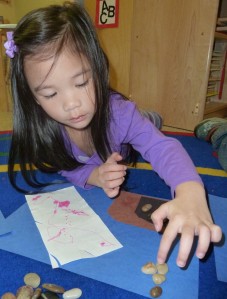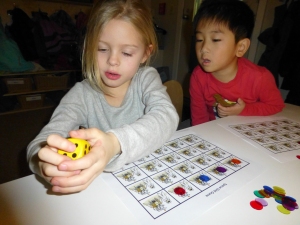 Last week we began our first “Mystery Project”. You might have noticed it penciled into the weekly specials schedule. The basic premise of Mystery Project was inspired by TLC Lessons I used many years ago in Kindergarten. This type of lesson is called a “directed art lesson”, but I would never call it an art project. I would call it a “following directions math lesson”. In my mind, an art project should be a creative expression of a person’s mood, thoughts, and ideas. Instead, Mystery Projects have specific directions for completion and practice targeted skills. I no longer use the designs and lessons created by the TLC group, but have integrated some of their ideas for introducing scissor and folding techniques in my plan.
Last week we began our first “Mystery Project”. You might have noticed it penciled into the weekly specials schedule. The basic premise of Mystery Project was inspired by TLC Lessons I used many years ago in Kindergarten. This type of lesson is called a “directed art lesson”, but I would never call it an art project. I would call it a “following directions math lesson”. In my mind, an art project should be a creative expression of a person’s mood, thoughts, and ideas. Instead, Mystery Projects have specific directions for completion and practice targeted skills. I no longer use the designs and lessons created by the TLC group, but have integrated some of their ideas for introducing scissor and folding techniques in my plan.
The Mystery Project you see on the right was created using basic shapes. Each child had a brown rectangle, a white rectangle, a large blue rectangle, and a black square. The children had to listen carefully to see which piece to use and whether to hold it “like a window” (horizontally) or “like a door” (vertically). We did talk about the correct mathematical terms, so if they start laying on the floor and talking about horizontal, don’t be too surprised.
The children also had to practice patience when learning how to cut the shapes. When doing Mystery Projects, we often want our rectangles and squares to become ovals and circles. For children who have had lots of experience cutting, their first plan is to begin trimming around and around and around the outside edge until they have a teeny, tiny ovoid. I teach them a different method. The first step is to use your scissors to cut off all of the corners. Next, you take itty bitty bites with your scissors to cut off all of the pointy parts. This gently rounds your shapes while remaining close to the original size of the rectangle/circle. It is also important to address the fact that sometimes we accidentally cut off too much. No Biggie! Just snip off the newly formed pointy parts.
A few days after our pictures were completed, we moved on to the manipulative portion of the mathematics activity. This part of Mystery Project was inspired by my experiences with Problem Solving with Story Boxes. In this instance, we are using our “math mat” to tell the story of some bears and their interactions with a cave and a child. I begin the lesson by telling the children a story that they can “act out” on their mat.
Once upon a time there were three bears in the cave. Then, four bears came and stood on top of the cave. How many bears were there all together?
For this story, we used rocks to represent bears. Mrs. Pless and I were looking at a few different skills as we watched how the children approached this problem. We observed an understanding of positional words, comfort with one to one correspondence when counting, and an understanding of combining sets. Most of these skills we do not expect to see fully developed at this time, but this gives us a chance to both differentiate for those who are ready and to support those who are at the beginning of their mathematical journey.
As a final practice, the children then join with a partner and play “My Turn, Your Turn”. Each student invents a new math story for their friend to act out using their mat. This gives us an even better concept of how well the children understood the activity.





